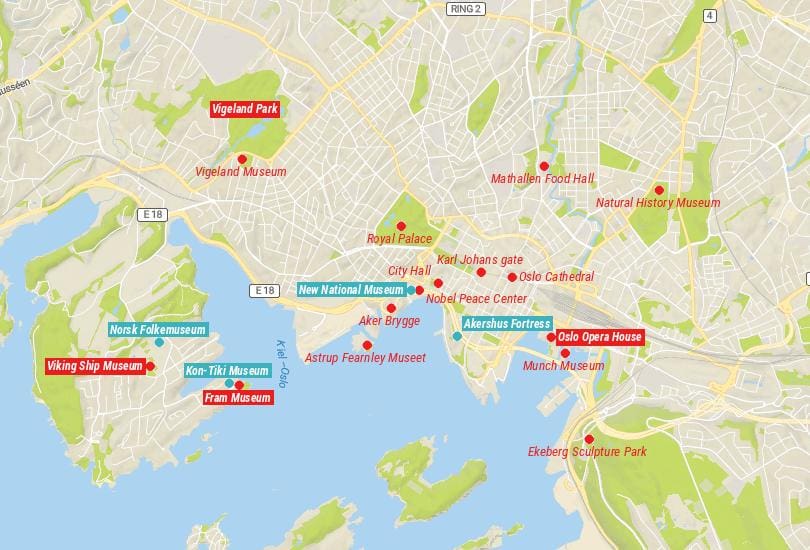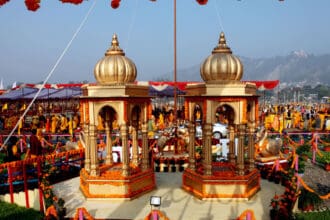Norway’s capital city, Oslo, is renowned for its stunning natural beauty, rich cultural heritage, and vibrant nightlife. From museums and art galleries to world-class restaurants and outdoor activities, there is something for everyone in this picturesque Scandinavian city. Whether you’re a history buff, an adventure seeker, or simply looking for a relaxing vacation, here are the top 23 attractions and things to do in Oslo.
Vigeland Sculpture Park
Vigeland Sculpture Park, located in the Frogner neighborhood, is one of Oslo’s most popular attractions. The park features over 200 bronze, granite, and cast iron sculptures created by Gustav Vigeland, one of Norway’s most famous sculptors. The centerpiece of the park is the Monolith, a 14.12-meter-tall sculpture carved from a single granite block.
The Norwegian Museum of Cultural History
The Norwegian Museum of Cultural History, located on the Bygdøy peninsula, is an open-air museum that showcases the country’s cultural heritage. Visitors can explore over 150 buildings from different regions and time periods, including farmhouses, stave churches, and traditional homes.
The Fram Museum
The Fram Museum, located on the Bygdøy peninsula, is dedicated to Norway’s polar exploration history. The museum houses the polar ship Fram, which was used by Fridtjof Nansen and Roald Amundsen on their expeditions to the Arctic and Antarctic.
The Viking Ship Museum
The Viking Ship Museum, located on the Bygdøy peninsula, houses three Viking ships that were discovered in burial mounds in the Oslofjord region. The ships, which date back to the 9th century, are incredibly well-preserved and offer a unique insight into Viking culture and shipbuilding techniques.
The Munch Museum
The Munch Museum, located in the Tøyen neighborhood, is dedicated to the life and work of Edvard Munch, Norway’s most famous artist. The museum features a collection of over 28,000 works, including paintings, prints, and drawings.
The Oslo Opera House
The Oslo Opera House, located in the Bjørvika neighborhood, is a stunning piece of modern architecture that has become one of Oslo’s most iconic landmarks. Visitors can take a guided tour of the building or attend a performance in one of its three theaters.
Akershus Fortress
Akershus Fortress, located in the heart of Oslo, is a medieval castle that has served as a royal residence, a prison, and a military stronghold over the centuries. Visitors can explore the castle grounds, visit the Royal Mausoleum, and enjoy panoramic views of the city from the fortress walls.
The Holmenkollen Ski Jump
The Holmenkollen Ski Jump, located on a hill overlooking Oslo, is one of the city’s most recognizable landmarks. Visitors can take a guided tour of the ski jump and learn about the history of skiing in Norway, or even try their hand at skiing on the nearby slopes.
The Oslofjord
The Oslofjord is a picturesque inlet that stretches over 100 kilometers from Oslo to the Skagerrak strait. Visitors can take a boat tour of the fjord to see the city from a different perspective, or explore the islands and beaches along its shores.
The Royal Palace
The Royal Palace, located in the heart of Oslo, is the official residence of the Norwegian monarch. Visitors can take a guided tour of the palace and learn about its history and architecture, or simply admire the grand facade and surrounding gardens.
The Astrup Fearnley Museum of Modern Art
The Astrup Fearnley Museum of Modern Art, located in the Tjuvholmen neighborhood, is a cutting-edge art museum that showcases works by both established and emerging artists. The museum’s striking architecture and impressive collection make it a must-see for art lovers.
The Kon-Tiki Museum
The Kon-Tiki Museum, located on the Bygdøy peninsula, is dedicated to the famous explorer Thor Heyerdahl and his expeditions across the Pacific. Visitors can see the original raft used in the Kon-Tiki expedition, as well as exhibits on Heyerdahl’s other voyages and discoveries.
The National Gallery
The National Gallery, located in the city center, is Norway’s premier art museum, with a collection that spans from the Middle Ages to the present day. The museum’s highlights include works by Norwegian artists such as Edvard Munch and Johan Christian Dahl, as well as international masters like Rembrandt and Picasso.
The Botanical Gardens
The Botanical Gardens, located in the Tøyen neighborhood, are a peaceful oasis in the heart of the city. The gardens feature over 7,500 plant species from all over the world, as well as several greenhouses and a rock garden.
The Norwegian National Opera & Ballet
The Norwegian National Opera & Ballet, located in the Bjørvika neighborhood, is a world-class performing arts venue that hosts opera, ballet, and other cultural events. The building’s sleek design and waterfront location make it a popular spot for both locals and tourists.
The Oslo City Hall
The Oslo City Hall, located in the city center, is a striking example of modernist architecture. Visitors can take a guided tour of the building and admire its impressive murals and sculptures, or attend one of the many cultural events that take place there throughout the year.
The Resistance Museum
The Resistance Museum, located in the Akershus Fortress, is dedicated to Norway’s resistance movement during World War II. The museum’s exhibits include artifacts, photographs, and personal stories that offer a glimpse into this important period in Norwegian history.
Aker Brygge
Aker Brygge is a trendy waterfront district that offers a mix of shopping, dining, and entertainment options. Visitors can stroll along the boardwalk, enjoy a meal at one of the many restaurants, or browse the boutique shops and galleries.
Bygdøy Peninsula
The Bygdøy peninsula is a popular destination for visitors to Oslo, with several of the city’s top museums and attractions located there. In addition to the museums already mentioned, visitors can also explore the Norwegian Maritime Museum, the Norwegian Folk Museum, and the Viking Planet interactive museum.
Grünerløkka
Grünerløkka is a hip and trendy neighborhood located just east of the city center. The area is known for its vibrant street art, boutique shops, and lively bars and cafes. Visitors can explore the area on foot, taking in the colorful murals and unique architecture, or simply enjoy a coffee and people-watching from one of the many sidewalk cafes.
The Munch Museum
The Munch Museum, located in the Tøyen neighborhood, is dedicated to the works of the famous Norwegian painter Edvard Munch. The museum’s collection includes many of Munch’s most iconic paintings, including “The Scream,” as well as sketches, prints, and other works on paper.
Vigeland Sculpture Park
Vigeland Sculpture Park, located in the Frogner neighborhood, is a sprawling park filled with over 200 bronze, granite, and cast iron sculptures by the Norwegian artist Gustav Vigeland. The park is one of Oslo’s most popular attractions, drawing visitors from around the world to see its impressive collection of figurative art.
The Viking Ship Museum
The Viking Ship Museum, located on the Bygdøy peninsula, is dedicated to the ancient Vikings and their seafaring traditions. Visitors can see three well-preserved Viking ships, as well as artifacts and interactive exhibits that bring Viking culture to life.
The Akershus Fortress
The Akershus Fortress, located in the city center, is a medieval castle that has served as a royal residence, a prison, and a military base over the centuries. Visitors can take a guided tour of the castle and its grounds, or simply wander around and enjoy the views of the harbor and city skyline.
The Oslo Cathedral
The Oslo Cathedral, located in the city center, is the main church of the Church of Norway in Oslo. The cathedral’s architecture combines elements of Gothic and Baroque styles, and its interior is adorned with beautiful stained glass windows and ornate carvings.
The National Museum of Science and Technology
The National Museum of Science and Technology, located in the Kjelsås neighborhood, is an interactive museum that showcases the history and development of science and technology in Norway. The museum’s exhibits include everything from early telegraphs and radios to modern space technology and renewable energy.
The Akerselva River
The Akerselva River is a scenic waterway that runs through the heart of Oslo, offering visitors a peaceful retreat from the hustle and bustle of the city. The river is lined with parks, walking trails, and cultural landmarks, and visitors can take a guided tour or explore on their own.
The Norwegian Museum of Cultural History
The Norwegian Museum of Cultural History, located on the Bygdøy peninsula, is a sprawling open-air museum that showcases the history and culture of Norway over the past 500 years. The museum’s exhibits include more than 150 historic buildings, as well as costumes, tools, and other artifacts that offer a glimpse into daily life in Norway.
Conclusion
Oslo is a vibrant and diverse city that offers something for everyone, from world-class museums and art galleries to scenic parks and outdoor activities. Whether you’re interested in history, culture, or just soaking up the atmosphere of a bustling city, there’s no shortage of things to see and do in Oslo.
FAQs
- What is the best time of year to visit Oslo?
- The summer months (June-August) are the most popular time to visit Oslo, but the city has something to offer year-round.
- What is the currency in Oslo?
- The currency in Oslo is the Norwegian krone (NOK).
- What is the best way to get around Oslo?
- Oslo has an extensive public transportation system, including buses, trams, and metro lines.
- Are there any free museums in Oslo?
- Yes, many of Oslo’s museums offer free admission, including the National Gallery, the Museum of Cultural History, and the Museum of Contemporary Art.
- Can you see the Northern Lights in Oslo?
- While it is possible to see the Northern Lights in Oslo, it’s not very common due to the city’s urban lights and location south of the Arctic Circle. For the best chance of seeing the Northern Lights, consider visiting a more remote area of Norway.


